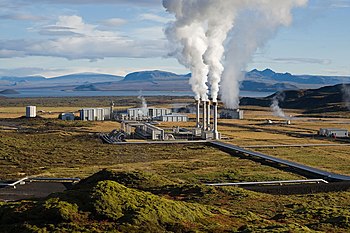Germany's “feed laws” permit German homeowners to connect to an electrical grid through some source of renewable energy and then sell back to the power company any excess energy produced at retail prices. This economic incentive has catapulted Germany into the number-one position among all nations with regards to the number of operational solar arrays, biogas plants, and wind turbines. The 50-terawatt hours of electricity produced by these renewable energy sources account for 10% of all of Germany's energy production per year. In 2006 alone, Germany installed 100,000 solar energy collection systems!
| The Nesjavellir Geothermal Power Plant in Þingvellir, Iceland. (Photo credit: Wikipedia) |
Also in the US, the battle rages on between Congress and the Geothermal Energy Association (GEA). Recent studies by the National Research Council, the Western Governors' Association Clean Energy Task Force and the Massachusetts Institute of Technology all support expanding geothermal research funding to develop the technology necessary to utilize this vast, untapped domestic renewable energy resource.
Supporters of geothermal energy, such as this writer, are amazed at the minuscule amount of awareness that the public has about the huge benefits that research and development of this renewable alternative energy source would provide the US, both practically and economically. Geothermal energy is already less expensive to produce in terms of kilowatt-hours than the coal that the US keeps mining. Geothermal energy is readily available, sitting just a few miles below our feet and easily accessible through drilling.
One company, Ormat, which is the third largest geothermal energy producer in the US and has plants in several different nations, is already a billion-dollar-per-year business—geothermal energy is certainly economically viable, and hopefully will eventually become a mainstream source of energy production for our country and others.


No comments:
Post a Comment